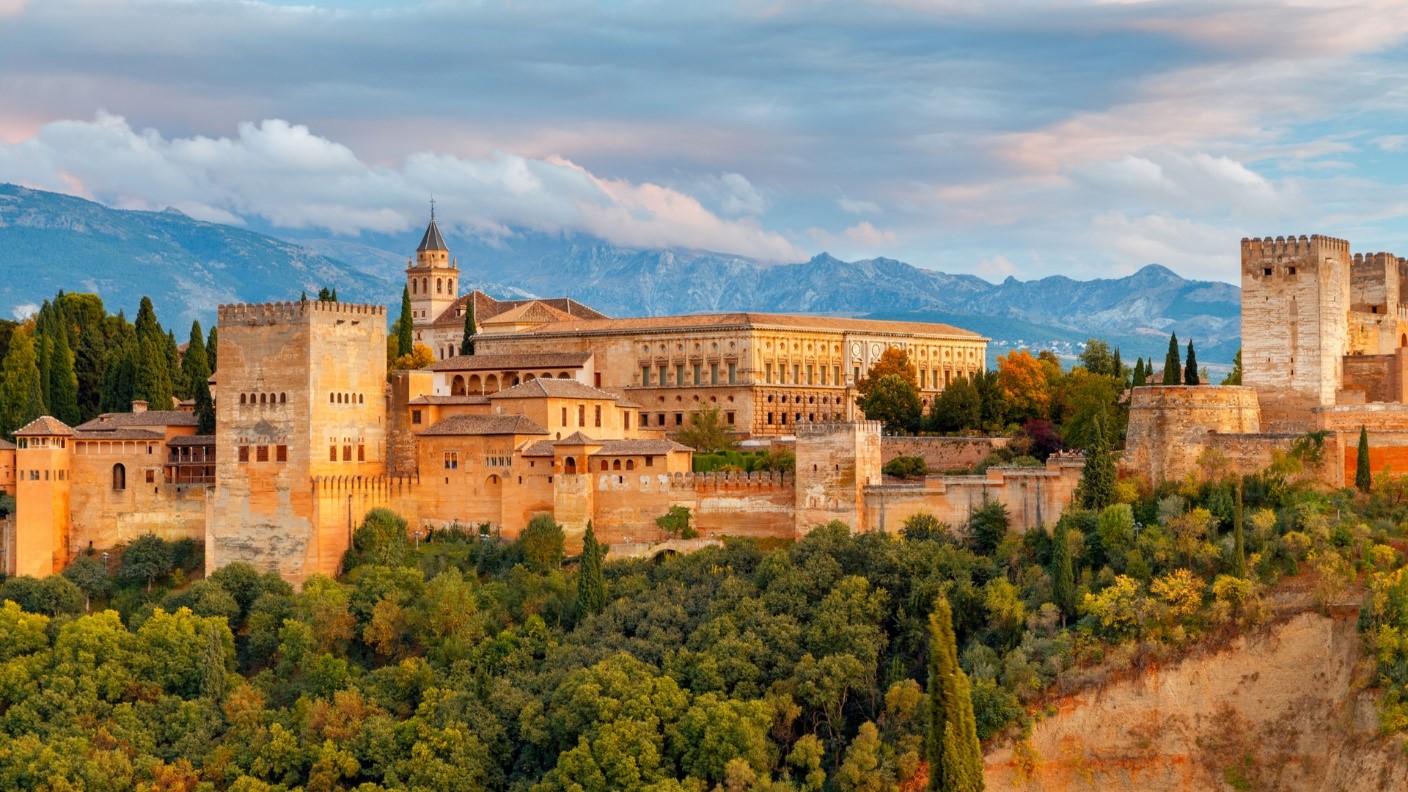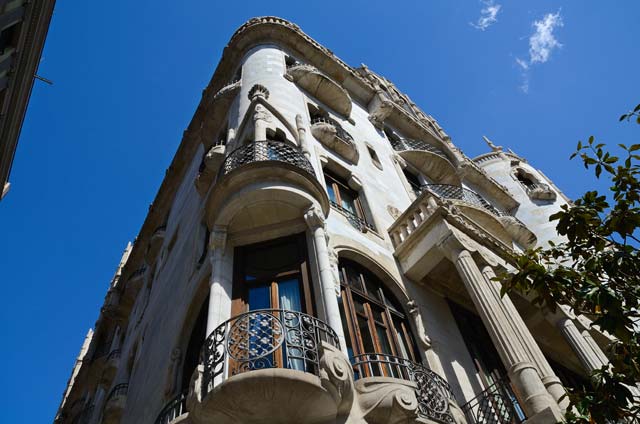By the end of XIX and beginnings of XX century, a new artistic movement spread throughout Europe that broke with the past and gave priority to craftsmanship and nature motifs over the rigid hierarchical structure of academic art.
Such movement was called different names: Art nouveau, Jugendstil, modern style, stile Liberty and Sezessionstil. In Barcelona, it is known as Modernism.
Barcelona's modernisme, as such is its name in Catalan, drank from the industrial revolution, from the well being of a powerful bourgeoisie, of the new great men, that set eyes in progress, and new ways of expression, of renovation.
Modernism was about to be seen everywhere, from a pharmacy to a street lamp, but it really started in the houses of the rich, those that made their fortunes in the flourishing textile industry or in Cuba, just to mention some examples, those that move from inside the city walls to live in the Eixample, that set of perfect squares or islands, part of the housing project by Ildefons Cerda.
Many artists participated in this ordeal of creativity, but a group of gifted architects took the leading part in giving birth to such magnificent cultural and historical legacy.
Today I would like to give you a succinct list of their major works of art. By choosing just some of them, I will certainly be unfair with the rest.
Here are
10 of the best modernist buildings that you must see in Barcelona:
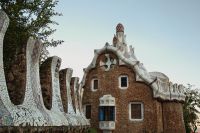 |
| Park Guell |
A new century was about to start, the influence of 1888 Universal Exhibition was still present and the city was expanding fast in the wake of Ildefons Cerda's ambitious plan.
Right before 1900, Eusebi Güell, Catalan industrial and politician, who made his fortune in the textile sector, entrusted his friend Gaudi with the design of a housing project that would accommodate well known families in a estate up in the neighboring hills around Barcelona.
From each of the projected 60 plots, happy owners were going to enjoy a privileged view of the sea and the city in a complex full of religious symbols and in harmony with Catalan traditions.
The ambitious dream never really fructified. In 1914 Count Güell abandoned his project. In 1922, four years after his death, the city town hall buys the property to his heirs and by 1926 it is inaugurated as a beautiful park and garden.
Lesseps
24, 92
Parc Güell, 116
Olot / Marianao,
24, 32, H6 CAP
Larrard
Read more about Park Güell
 |
| Palau de la Musica |
Being second does not mean
Palau de la Musica is my second best! In my opinion this is one the most beautiful. In fact, this is only a recommendation of my best ten modernista buildings.
When you approach the Palau (palace), the first thing you notice is that this is too much of an architectural marvel for the streets that surround it and that it is difficult to frame a decent picture due to short distance you have to shoot.
But why did Lluis Domenech i Montaner designed and built this? What was the purpose of a concert hall here?
Well, we have to thank, the board of directors of the Orfeó Català choral society, presided by Joaquim Cabot, a renown jeweler. They bought a small plot of irregular shape at Sant Pere quarter and assigned Montaner with the project. Orfeó Català, founded by Lluís Millet and Amadeu Vives and inspired by the choral works of Catalan composer Josep Anselm Clavé, definitely needed a building after a series of concerts in the
1888 Barcelona Universal Exposition and the growing success of their choir and institution.
The construction lasted only three years!
From 1905 to 1908, and not without difficulties, Montaner, managed to give fantastic solutions to the space and illumination problems inherent to the place.
Did you know that Palau de la Musica's first stone was laid on Sant Jordi's day or that in 1920s, some architects thought of demolishing the building for being too extravagant?
Maybe it was, but if the quest of a new identity by the local bourgeoisie and its explosion of creativity, brought a concert hall like this, then we are very lucky to inherit it and we embrace it in awe.
Visualize a stained glass skylight that weighs a metric ton where you can see angels singing around the sun in the shape of an inverted bell hanging over your head, while you watch your favorite concert performed in a stage full of muses and Wagnerian valkyries.
Look, I would be here depicting for hours what your imagination cannot recreate without watching this beauty yourselves.
Maybe this incredible
Palau de la Musica Catalana VR gives you an idea.
Or even better, come to Barcelona and
plan your Palau de la Musica visit online or directly at the box office.
Urquinaona
V15, V17, 45
Via Laeitana
39, 42, 55, H16
Plaça Urquinaona.
Read more about Palau de la Musica
 |
| Casa Mila |
The last civil work of Gaudi before completely getting absorbed by his famous cathedral was
La Pedrera or
Casa Mila, a modernist building that raised a lot of controversy in local newspapers by the time it was finished in 1910.
Pere Mila, who by the way owned La Monumental bull ring, was one of those prosperous businessmen craving for a splendorous house in Passeig de Gracia that represented his social status within the wealthy families of the buoyant Catalan bourgeoisie. He commissioned Antoni Gaudi with the project. By that time, the architect was busy with the restoring works in Casa Batllo. Mila's father and the promoter at the Batllo house, were partners.
Gaudi took too many liberties that displeased Mila and his promoters and although this was meant to be the culmination of his work besides Sagrada Familia, he had to deal with complaints about his expenditures and his way too daring architectural eccentricities.
La
Pedrera, catalan word for quarry. was the final popular nickname given to the house inspired in the many blocks of cut stone visible on the façade. A façade whose undulated horizontal lines create the illusion of an animated living organism.
 Diagonal
Diagonal
Lines: 7, 22, 24, 39, V15
Read more about Casa Milà
 |
| Casa Batllo |
Josep Batlló, yet another wealthy entrepreneur that wanted to live in the most renown street in L'Eixample de Barcelona and in Ildefons Cerda's plan, bought in 1903 a building that dated from 1877 by architect Emily Sala Cortès, one of Gaudi's teachers at the school of architecture.
By the times Batlló acquired the house, Casa Amatller was way to sumptuous to compete and it happened to be next door, so he put his faith in a very popular artist at that moment, Antoni Gaudi.
Instead of demolishing the rather sober building as suggested by the owner, the architect carried out an extraordinary restoration that was audacious and functional at the same time. The result was brutally attractive and efficient, for generations to admire.
 Passeig de Gracia
Passeig de Gracia
Lines:
H10, V15, 7, 22 y 24.
Renfe:
Passeig de Gracia
FGC:
Provença
Read more about Casa Batlló
 |
| Stain Glass Casa Amatller |
It is not strange that the house of a
chocolatier like Antoni Amatller i Costa, looks like a chocolate tablet.
This third generation businessman carried on with the traditional manufacturing of the Amatller family founded in 1797, by opening in 1878, a modern brand new chocolate factory with the latest production techniques acquired during his travels in Europe.
The capital amassed from then on, allowed Mr. Amatller to become an art collector, a prestigious photographer and painter. He was a visionary that invested in publicity for his products using art nouveau illustrations by the best artists of his times. So well he did that he entered the Passeig de Gracia elite of proud owners of ostentatious modernista houses.
The house that we see nowadays is in fact the exquisite refurbishing that Josep Puig i Cadafalch made over an 1875 original building which was rather austere. The famous architect, who inspired most of his followers with this masterpiece, added gothic details to a ridged façade, to this crow-stepped gable with clear Flemish or Nordic architecture influence.
Casa Amatller inaugurated in 1900 broke with the predominant architectural concepts of Passeig de Gracia and paved the way for new modernist ideas in the years to come.
The first famous construction of the block was about to start a rivalry of patrons over who was to build the most magnificent house. This fight for commissioning the most opulent
casa modernista in one specific block of Passeig de Gracia eventually created
L'Illa de la Discòrdia or The Block of Discord.
 Passeig de Gracia
Passeig de Gracia
Lines:
H10, V15, 7, 22 y 24.
Renfe:
Passeig de Gracia
FGC:
Provença
Read more about Casa Amatller
 |
| Casa Lleo i Morera |
Declared by the Town Hall, best artistic building of the year in 1905,
Casa Lleo i Morera constitutes an efficient solution by Lluis Domenech i Montaner on the limitations of an irregular estate and an asymmetric
façade.
On the corner of
Passeig de Gracia and
Consell de Cent, you come across one of the most beautiful modernista houses
that are part of the Illa de la Discordia or Block of the Discord.
This was also a restoration and a very good one, of course. Domenech i Montaner was one the most popular architects of the moment. Remember that he also built Hospital de Sant Pau, Palau de la Musica Catalana and Casa Fuster among other outstanding works.
In this case, the original building came to the hands of their owners by inheritance. Francesca Morera i Ortiz got it from an uncle that had become rich in America. The presence of nearby Casa Amatller pushed Mrs. Morera to decide that she was not second to none, so in the wake of many other rich members of Catalan bourgeoisie, she summoned Montaner
and put him in charge of the renovation.
It happened that the illustrious lady did not survive the house inauguration by one year.
Do not miss this
virtual tour of Casa Lleo i Morera!
Only the first floor is open to the public by guided tour only.
 Passeig de Gracia
Passeig de Gracia
Lines:
H10, V15, 7, 22 y 24.
Renfe:
Passeig de Gracia
FGC:
Provença
Read more about Casa Lleó i Morera
 |
| Palau Baro de Quadras |
The Palau (palace) del Baro de Quadras is yet another good sample of those grandiloquent dreams of the bourgeoisie and the nobility at the beginnings of the XX century.
The aftermath of the industrial revolution, the 1888 Universal Exhibition in Barcelona, the accruing of wealth coming from the textile industry or the fortunes made in Cuba by the
indianos, (Spanish emigrants in America) created a breeding ground for this eagerness to excel by spending every dime in artistic expression and where better than your own house to start with. In 1906, Manuel Quadras i Prim, fulfilled such a dream.
The Baron, son of a rich textile businessman, commissioned Josep Puig i Cadafalch to restore a house in Diagonal avenue, one of the main streets conceived by the urban planner Ildefons Cerdà. The estate had been inherited from his father and needed to be refurbished in accordance with the new noble status of his owner.
Cadafalch, who had worked for Quadras in the past, knew well what he had to do to express the desires of his patron. As it happened that there were two façades, one facing Diagonal and the other carrer Roselló, and bearing in mind that the three upper levels were meant to be apartments for rent, the architect designed an opulent entrance of neo-plateresque style for the proprietor in the avenue and a back sober entrance on the other side for the tenants.
The balcony, featuring busts of
medieval and Renaissance figures, floral adornments and heraldic symbols and the neo gothic staircase shown in the picture above are a must see.
More information here:
Palau Baro de Quadras

Diagonal
Lines: 6, 33, 34, 39, H8, V17
Read more about Palacio del Baro de Quadras
 |
| Casa Comalat |
Unfortunately this precious gem of modernisme is not open to the public but that does not mean it is not worth noting down in your list of must see places for your art nouveau route in Barcelona.
Featuring also two completely different façades, Casa Comalat is beautiful enough to satisfy your curiosity and admiration for architecture.
Although the main side is on 442 Diagonal, it is the 316 Còrsega street façade, shown here in the picture that draws more attention.
Built between 1906 and 1911 the house is named after his owner Mr. Comalat, a money lender that assigned the project to architect
Salvador Valeri i Pupurull. Resources were not a problem so only the best were hired to participate in the construction. Lluis Bru i Salelles was the artisan in charge of the interior decoration and the polychrome ceramic work on the undulated balconies and the roof parapet. The stain glass windows came from the hands of renowned Rigalt i Granell company.
The projecting bay is made of several party walls created with a system of narrow roller-shuttered windows. This is one of the differentiating traits of Casa Comalat with the rest of
casas modernistas, the shutters. Also the excess of ornaments makes it unique, as the building is part of
late modernisme in Barcelona.
It is a pity that
the interior of Casa Comalat is not open to the public.
 Diagonal
Diagonal
Lines: 6, 33, 34, H8, V17
Read more about Casa Comalat
 |
| Hospital de Sant Pau |
The biggest modernist complex on earth, declared world heritage by UNESCO in 1997, Hospital de la Santa Creu i Sant Pau was not always where it is now.
It all started with an obsolete gothic building in XV and a generous 'handout' from a Catalan living in Paris, an prosperous banker with investments in key industrial sectors. This generous savior was called, Pau Gil i Serra.
Mr. Gil died in 1892, but his will had been written some years before. It stated that a hospital honoring Sant Pau (St. Paul) should be built in Barcelona using part of his capital but not in any odd place. There was only one condition, it had to be constructed in a place with maximum health conditions. Obviously the gothic building in old Raval quarter did not meet this requirement, so the Hospital accepted to leave the unhealthy premises, took the money from the inheritance and donated land of their own for the occasion.
The project was assigned to the acclaimed architect Lluis Domenech i Montaner who set to design 48 pavilions of which only 27 were finally built, all connected by underground corridors. Seen from above, the modernista compound resembles a giant cross, inclined 45 degrees with respect to the rest of buildings in the Eixample district.
By the way, the
recinte modernista of Sant Pau is very near Sagrada Familia, so in my modest opinion, it would be better to combine them both instead of visiting Sagrada Familia and Park Güell the same day, as it seems to be the general trend with tourists lately.
 Sant Pau
Sant Pau
Lines: Carrer Sant Quintí
: 192
Carrer Sant Antoni Maria Claret
: H8, 19, 20, 45, 47, 50, 51, 117, N1, N4
Carrer Cartagena: 192, N0
Read more about Hospital de Sant Pau
 |
| Sagrada Familia |
And last but in no way least, the cherry on top, the cream of the crop,
the opus magnum of Modernism by the master of masters, architect Antoni
Gaudi.
This everlasting but never ending project that Gaudi could not finish as he died accidentally at the age of 73, three days after being hit by a tram, occupied 43 years of his lifetime. Time enough to leave behind a well defined plan to continue in his footsteps and to find the eternal light at the end of his long visionary tunnel. In fact, the basilica is in the final stages of construction and it is estimated to be ready by year 2030.
It all started back in 1872, when Josep Maria Bocabella, a very religious man and librarian, had returned from his trip in Italy and decided that the city needed to devote a temple to La Sagrada Familia. After buying some property in L'Eixample of Cerda, he commissioned architect Francisco de Paula del Villar to work on his idea. There were discrepancies between Villar and Martorell, who was Bocabella's advisor. The result: a young Gaudi is given the new assignment which he turned into the temple of perfection.
The result of his genius, the legacy of a one and only man was about to become a daunting jewel of architecture that should undoubtedly be considered part of the new wonders of the modern world.
 Sagrada Familia
Sagrada Familia
Lines: Mallorca / Marina: 19, 33, 34, 50, 51, H10
Read more about La Sagrada Familia
The purpose of this post is to open your eyes and your heart to the beauty of an art movement called modernisme that took many liberties to run away from a rigid past and taught us that there are no limits to human imagination. It would be great if you took a minute to share it. Thanks!








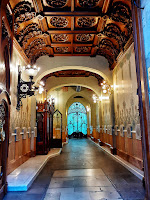
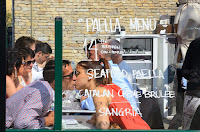
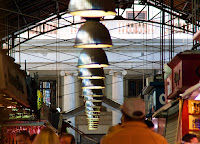
.jpg)








